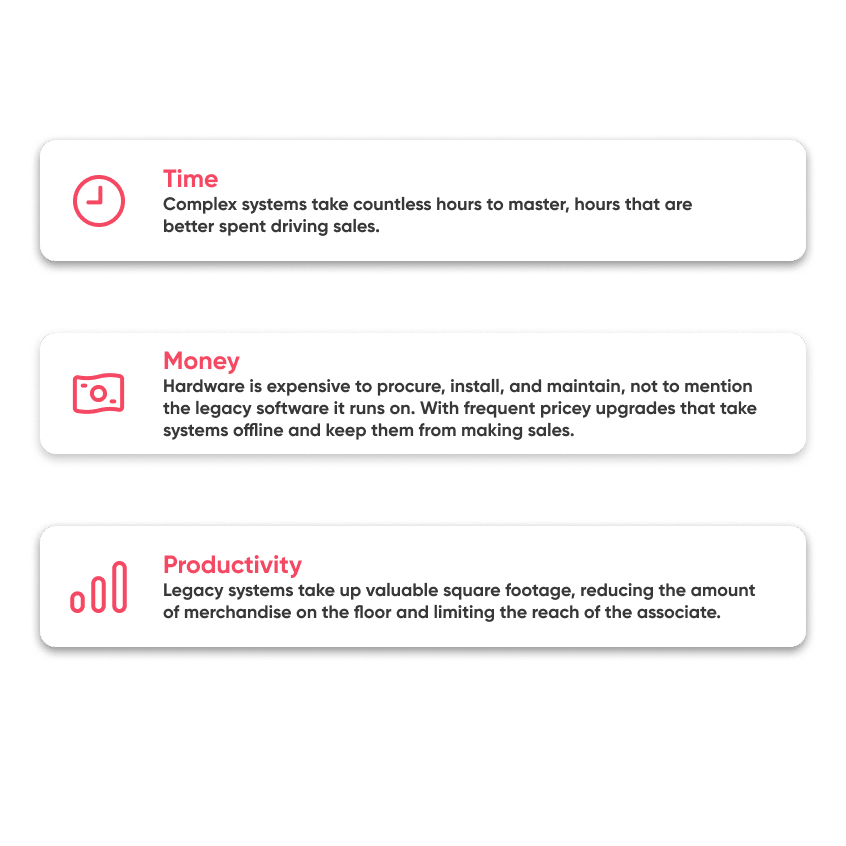The huge cost consumer is in need of some serious optimization
POS systems are at the heart of store operations. But, outdated legacy POS systems can be very costly in 3 crucial areas— time, money, and productivity.

While this information seems daunting, you don’t have to be scared of your POS. The right POS system can actually be cost efficient and help retailers save time and money, and be more productive overall.
Here are the 7 hidden costs of your POS system, and ways to reduce them.
Hardware doesn’t have to cost an arm and a leg
Mobile POS systems are much more cost effective, both in the short term and the long run.
Traditional registers range anywhere from $1000-$3000 a piece. Legacy POS systems require a store server, especially in larger stores, which implies an initial and recurring cost over time. Considering the functionality of legacy POS systems is limited to checkout only, the ROI is restricted to in-store sales only.
Modern, mobile-first POS systems, such as iPads, are gaining popularity and cost $200-$500 each. Even with peripheral hardware (i.e. scanner, case, credit card reader, tilt) the overall cost is still much less. Using a mobile device provides a host of benefits which we’ll discuss in more detail below, such as:
- Does not require a static location in the store, which helps reduce checkout wait time— 86% of customers leave stores due to long lines.
- Cloud-based operating systems allow for easy transfer of information and system upgrades.
- Nature of the device allows it to serve multiple functions, such as inventory tracker, store productivity, and even client capture and outreach.
Accurate inventories save money
Real-time inventory updates help associates save the sale, even with outstock
There are two ways that accurate inventories help to save money, here’s what they look like. In stores, shrinkage is a big problem, averaging from 1.44% to 2% of sales in retail. Although that might sound low, this accounts for tens of billions of dollars in losses for retailers each year. Inventory shrinkage can be caused by theft, damaged or obsolete inventory, or even administrative errors. A POS may not solve the issue, but it can ensure proper inventory control tools and processes that aren’t subject to human error
With a store inventory updated close to real-time, you can expose an accurate inventory (ATP) to the network thus reducing denied product and cancellations across channels.
Sam wants to buy a TV he found online. This TV is the last stock from the previous year, so there is only one left in the store. He wants to make sure he gets it, so he places the order online to pick it up the next day. The problem is that Jean went to the store earlier and bought that same TV. Since the inventory is not updated in real-time, it is going to take 1-3 days (if not more) for someone to notify Same that his purchase can’t be completed. Resulting in him showing up to the store the next day, only to leave disappointed and less likely to shop there again.
Associates that have an updated omnichannel inventory can see almost immediately if an order cannot be completed due to stock. They can then proactively reach out to the respective customer to notify them and then make suggestions for similar products that are available in order to save the sale.
Reducing returns keeps revenue in your pocket
Ensuring customers are satisfied with their purchase the first time reduces loss of profit from returns
Returns are a silent killer. Across channels, returns decrease the revenue from sales, and may actually end up costing retailers money. Online returns may be subject to shipping and digital transaction fees. And once returned, merchandise sometimes needs to be placed in the sale or outlet sections thus further losing money.
With the right tools, associates can make sure customers are satisfied with their purchase the first time. Associates need to be able to take the information that customers provide on what they’re looking for, and find specific products that fit their needs. Having direct access to the full product catalog, including seasonal merchandise and online exclusives, gives them this ability. Overall, this will reduce the number of items returned to the stores, and keep the revenue earned.
Every labor hour counts, training needs to be efficient
Getting associates up to speed quickly optimizes sales time
New associates need to become brand experts across channels almost instantly. But, traditional POS are hard to understand and use. To ring a promotion you need to press F7 then F5 type a promo code, then press enter and scan the barcode…. you get the idea. On average, it takes about 40 hours to learn a POS. You shouldn’t be paying people valuable labor hours to learn a complicated system.
Super intuitive POS systems can drastically cut down the amount of time it takes to train new hires, and get them on the floor as quickly as possible. Getting realistic, hands-on experience for new hires as soon as they walk in the door ensures a quick learning curve as well as ongoing, uniform education across an entire brand. Mobile systems can give accurate, on-the-spot instruction for boosting productivity and driving sales so associates receive continuous training throughout their lifecycle.
Your POS can increase store productivity in three ways
Mobile POS systems make the most of valuable floor space and associate interactions
A highly important (although outdated) metric in retail is sales per sq ft. The square feet required to have large, bulky registers and a checkout queue significantly decreases the amount of space you have for merchandise. By switching to mobile solutions you free up valuable square footage of retail space. More room to exhibit merchandise means more opportunities to make a sale.
Identifying how much space you can save with mobile POS is also an important metric when it comes to scalability. Store rent is not cheap. The more sq ft you need, the more you will be paying each month. By shrinking the number of square feet you need, you can save on rent by optimizing smaller spaces as the business grows.
Mobile POS also ensures that associates can remain by the customer’s side throughout their shopping journey to digitally record vital information that will help build rapport with the customer and help influence sales. Customers who engage with instore technology spend up to 4x longer shopping than those who do not. That is valuable time that associates can spend building relationships with them. Instead of needing associates standing on registers for their whole shift, retailers can focus on allocating their talent to value-add tasks. Making the most of every head in the store.
Additionally, next-gen mobile POS broadens the scope of the associate by enabling them to sell merchandise that isn’t on the floor. Traditional legacy POS systems aren’t equipped to make omnichannel sales, so when a customer walks into a store and can’t find their size and can’t place an order to their house, they walk out and that sale is lost forever. Next-gen, omnichannel POS systems empower store teams with cross-channel capabilities so that even without the right products in-store, they can still keep selling.
Accurate information helps store teams turn inventory efficiently
Data needs to be accessible, so that business decisions can be made strategically to maximize sales
Modern POS systems record local purchases and interpret the data to identify trends and patterns in the local market. With this data, associates know who to sell what products to, and how to market them. Instead of having to guess what products will sell best, or pushing a set of corporate-defined looks, associates can interpret data themselves to provide an authentic experience.
These metrics are also important for managers to know how much of each item to order based on trends and patterns. Stores should be able to increase their stock turns thus reducing the need to put products on sale at the end of the season. By knowing what products do well in what stores, managers can ensure that they order the right amount of items to efficiently turn inventory season over season.
Bringing it all together
The right POS has the power to influence a retailer’s success through:
- Cost efficiency— Modern POS systems are cost effective, and have a host of features that are sure to deliver ROI by reducing even the hidden costs.
- Saving time— The intuitive nature of the modern POS means new associates are able to get hands-on sales experience as soon as they walk in the door and continuously throughout their lifecycle.
- Increasing productivity—Every inch of the store floor counts, the less space you need for your POS, the more room you have for inventory. Mobile POS saves space and creates a clean, frictionless experience for customers.
Want to learn more about how a next-gen POS can cut costs in your store? Contact us today!


